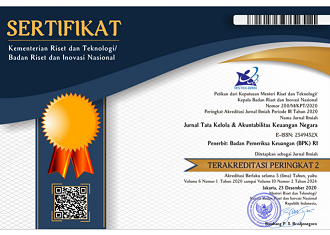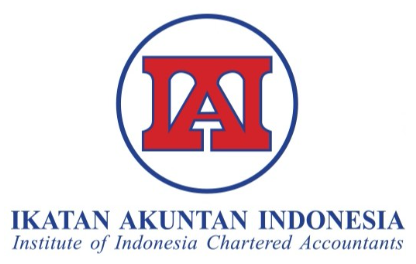Factors Determining Low Regional Financial Independence: Financial Autonomy and Degree of Decentralization
DOI:
https://doi.org/10.28986/jtaken.v8i1.701Keywords:
Financial Autonomy, local government, mandatory spendingAbstract
This study aims to assess the Tulang Bawang Regency's fiscal independence and determine the factors that affect it. This study used the data of the 2015-2019 Statement of Budget Realization of Tulang Bawang Barat Regency and primary data from interviews. The research method applies a qualitative approach with an inductive methodology using several financial ratios such as the effectiveness of Local Own-source Revenue management, the ratio of the degree of decentralization, the ratio of regional financial dependence, and the ratio of regional financial independence. Based on the results, the ratio of regional financial independence shows an average of 1.54%, within the 0-25% interval, and classified under the shallow criteria. It may be inferred that regional financial independence in meeting its funding needs for the administration of government affairs is still very low. The regional financial dependence ratio shows an average of 85.99%, categorized as a very high dependency. The calculation of the ratio results proves that the local own-source revenue of Tulang Bawang Barat Regency is still low. Furthermore, a large number of mandatory spending from the central government and national budgeting politics causes the regional financial independence of Tulang Bawang Barat Regency to become low.
References
Afif, F. Y, & Ciptawaty, (2020). Kemandirian keuangan daerah dan pertumbuhan ekonomi Kabupaten/Kota Lampung Tahun Anggaran 2014-2018. E-Jurnal Ekonomi dan Bisnis Universitas Udayana, 09(07), 609-626. DOI: 10.24843/EEB.2020.v09.i07.p02
Arif, A., & Maksum, I. R. (2017). Functional decentralization constructs in decentralization policy in Indonesia (A study of irrigation, education, and free trade sectors). Jurnal Kebijakan Dan Administrasi Publik, 21(1), 55-75. DOI: 10.22146/jkap.25383
Babczuk, A., & Więznowski, A. (2008). The revenue autonomy of self-government in selected EU Countries. Argumenta Oeconomica, 1(20), 67–81. Retrieved from https://dbc.wroc.pl/Content/40113/PDF/Babczuk_The_Revenue_Autonomy_Of_Self_Governments_2008.pdf
Barbieri, D., Galli, D., Fedele, P., & Ongaro, E. (2013). Drivers of autonomy of public agencies in Italy. Financial Accountability and Management, 29(1), 26–49. DOI: 10.1111/faam.12001
Bazeley, P., & Richards, L. (2011). The NVIVO qualitative project book. London: SAGE Publications, Ltd. DOI: 10.4135/9780857020079
Bowen, T. R., Chen, Y., & Eraslan, H. (2014). Mandatory versus discretionary spending: The status quo effect. American Economic Review, 104(10), 2941–2974. DOI: 10.1257/aer.104.10.2941
Camagni, R. (2002). On the concept of territorial competitiveness: Sound or misleading? ERSA Conference Papers ersa02p518. European Regional Science Association, 39(13), 2395–2411. DOI: 10.1080/004209802200002702
Cigu, E. (2014). An approach of local financial autonomy and implication over sustainable development in the knowledge society. Journal of Public Administration, Finance and Law, 06, 44–53.
da Cruz, N. F., Tavares, A. F., Marques, R. C., Jorge, S., & de Sousa, L. (2016). Measuring local government transparency. Public Management Review, 18(6), 866–893. DOI: 10.1080/14719037. 2015.1051572
de Sousa Santos, B. (1998). Participatory budgeting in Porto Alegre: Toward a redistributive democracy. In Politics and Society, 26(4), 461–510. DOI:10.1177/0032329298026004003
de Sousa, K. M., Pinhanez, M. D. M. S. F., do Monte, P. A., & Diniz, J. A. (2020). Salary, financial autonomy, and efficiency of healthcare systems in local governments. Applied Economics Letters, 27(2), 122–126. DOI: 10.1080/13504851.2019.1610697
Government of Tulang Bawang Barat Regency. (2015). The Statement of Budget Realization (Laporan Realisasi Anggaran, LRA) Year 2015. Lampung: Government of Tulang Bawang Barat Regency.
Government of Tulang Bawang Barat Regency. (2016). The Statement of Budget Realization (Laporan Realisasi Anggaran, LRA) TA 2016. Lampung: Government of Tulang Bawang Barat Regency.
Government of Tulang Bawang Barat Regency. (2017). The Statement of Budget Realization (Laporan Realisasi Anggaran, LRA) TA 2017. Lampung: Government of Tulang Bawang Barat Regency.
Government of Tulang Bawang Barat Regency. (2018). The Statement of Budget Realization (Laporan Realisasi Anggaran, LRA) TA 2018. Lampung: Government of Tulang Bawang Barat Regency.
Government of Tulang Bawang Barat Regency. (2019). The Statement of Budget Realization (Laporan Realisasi Anggaran, LRA) TA 2019. Lampung: Government of Tulang Bawang Barat Regency.
Grechyna, D. (2021). Mandatory spending, political polarization, and macroeconomic volatility. European Journal of Political Economy, 68, 101990. DOI: 10.1016/j.ejpoleco.2020.101990
Halim, A. (2004). Akuntansi Keuangan Daerah. Jakarta: Salemba Empat.
Herianti, E. (2019). Budget turbulence and budget deviation: Do local governments have the ability to reduce them? Jurnal Tata Kelola Dan Akuntabilitas Keuangan Negara, 5(1), 1–20. DOI: 10.28986/jtaken.v5i1.285
Jemna, D., Onofrei, M., & Cigu, E. (2013). Demographic and socioeconomic determinants of local financial autonomy in Romania. Transylvanian Review of Administrative Sciences, 46–65.
Kamaroellah, R. A. (2017). Analisis tingkat kemampuan keuangan daerah dalam mendukung pelaksanaan otonomi daerah. NUANSA: Jurnal Penelitian Ilmu Sosial Dan Keagamaan Islam, 14(1), 123. DOI: 10.19105/nuansa.v14i1.1316
Karenina, S., Andayani, K. D., Aditya, I. A., & Wasil, M. (2021). Tingkat kemandirian keuangan daerah dan implikasinya terhadap pertumbuhan ekonomi Kabupaten Bojonegoro Tahun 2010-2019. Journal of Regional Economics Indonesia, 2(1), 27–41.
Law of The Republic of Indonesia Number 23 of 2014 concerning Local Government (Undang-Undang Republik Indonesia Nomor 23 Tahun 2014 tentang Pemerintah Daerah). Retrieved from https://peraturan.bpk.go.id/Home/Details/38685/uu-no-23-tahun-2014
Law of The Republic of Indonesia Number 33 of 2004 concerning Financial Balance between the Central Government and Local Governments in lieu of Law Number 25 of 1999 regarding Financial Balance between Central and Local Governments (Undang-Undang Republik Indonesia Nomor 33 Tahun 2004 tentang Perimbangan Keuangan antara Pemerintah Pusat dan Pemerintahan Daerah). Retrieved from https://peraturan.bpk.go.id/Home/Details/40770/uu-no-33-tahun-2004#:~:text=Undang%2DUndang%20Nomor%2033%20tahun,Hasil%20diatur%20dengan%20Peraturan%20Pemerintah.
Maličká, L. (2019). Formal dimension of fiscal decentralization in the context of vertical fiscal imbalance and financial autonomy of municipalities in Slovakia. Politicka Ekonomie, 67(3), 273–290. DOI: 10.18267/j.polek.1240
Mardiasmo. (2006). Otonomi dan Manajemen Keuangan Daerah (1st ed.). Yogyakarta: Penerbit Andi.
Mitsopoulos, M., & Pelagidis, T. (2008). Comparing the administrative and financial autonomy of higher education institutions in 7 EU countries. Intereconomics, 43(5), 282–288. DOI: 10.1007/s10272-008-0262-y
Ngadisah, N., & Alma’arif, A. (2019). Peran dan fungsi Bumdes dalam pembangunan perdesaan (Studi pada Desa Bleberan Kecamatan Playen DIY). Jurnal Manajemen Pembangunan, 2(1).
Olson, W. P. (2012). Fairness, financial autonomy, and independence: Lessons from regulated industries. Electricity Journal, 25(1), 57–67. DOI: 10.1016/j.tej.2011.12.005
Oulasvirta, L., & Turala, M. (2009). Financial autonomy and consistency of central government policy towards local governments. International Review of Administrative Sciences, 75(2), 311–332. DOI: 10.1177/0020852309104178
Phaup, M. (2019). Budgeting for mandatory spending: Prologue to reform. Public Budgeting and Finance, 39(1), 24–44. DOI: 10.1111/pbaf.12210
Psycharis, Y., Zoi, M., & Iliopoulou, S. (2016). Decentralization and local government fiscal autonomy: Evidence from the Greek municipalities. Environment and Planning C: Government and Policy, 34(2), 262–280. DOI: 10.1177/0263774X15614153
Rante, A., Mire, M. S., & Paminto, A. (2018). Analisis kemandirian keuangan daerah. Inovasi, 13(2), 78–89. DOI: 10.29264/jinv.v13i2.2461
Saldaña, J. (2009). The coding manual for qualitative researchers. London: SAGE Publication, Ltd. Retrieved from https://emotrab.ufba.br/wp-content/uploads/2020/09/Saldana-2013-TheCodingManualforQualitativeResearchers.pdf
Saunders, C. (2018). Financial autonomy vs. solidarity: A dialogue between two complementary opposites. In Comparing Fiscal Federalism (pp. 40–41). DOI: 10.1163/9789004340954
Scutariu, A. L., & Scutariu, P. (2015). The link between financial autonomy and local development: The case of Romania. Procedia Economics and Finance, 32(15), 542–549. DOI: 10.1016/s2212-5671(15)01430-6
Suci, S. C., & Asmara, A. (2014). Pengaruh kemandirian keuangan daerah terhadap pertumbuhan ekonomi Kabupaten/Kota Provinsi Banten. Jurnal Ekonomi Dan Kebijakan Pembangunan, 3(1), 8–22.
Tarmizi, R. (2010). Pendapatan asli daerah berdampak pada kemandirian keuangan daerah. Jurnal Akuntansi Dan Keuangan, 1(1), 123. DOI: 10.36448/jak.v1i1.13
Waluyo, B. (2018). Balancing financial autonomy and control in agencification: Issues emerging from the Indonesian higher education. International Journal of Public Sector Management, 31(7), 794–810. DOI: 10.1108/IJPSM-10-2017-0272
Zarista, E., & Ichsan, M. (2020). The roles of political power in budget process: How to accomodate them? A case study. Jurnal Tata Kelola Dan Akuntabilitas Keuangan Negara, 6(1), 87–102. DOI: 10.28986/jtaken.v6i1.412
Downloads
Submitted
Accepted
Published
How to Cite
Issue
Section
License

Jurnal Tata Kelola dan Akuntabilitas Keuangan Negara is licensed under
a Creative Commons Attribution-ShareAlike 4.0 International License




















